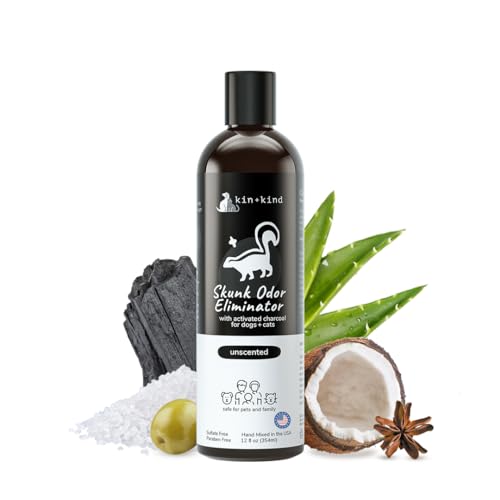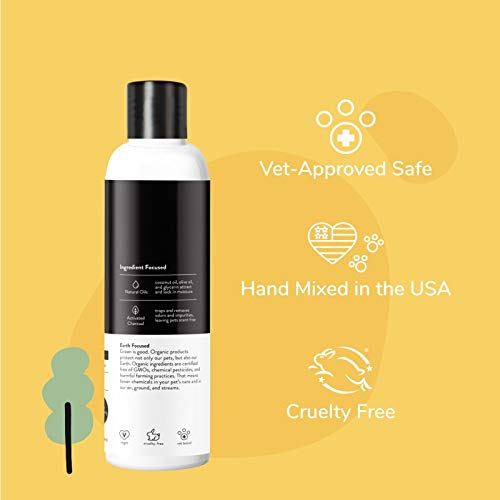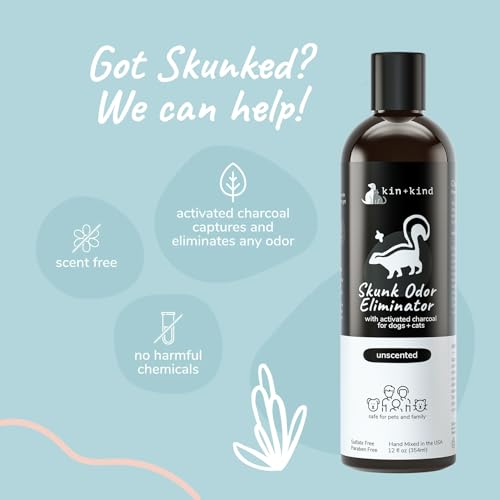


kin+kind Dog Shampoo - Activated Charcoal for Skunk Odor Relief, Vet Approved - 12 fl oz


Carbon
High RiskCarbon is an amorphous form of elemental carbon commonly used in various products. It serves multiple functions, including acting as a pigment, filler, or adsorbent, depending on the formulation. Its versatile applications span across personal care, cosmetics, and other industries.
Sustai Insights
Carbon has functional benefits such as enhancing product texture and stability. It is generally considered low in health risks, with minimal concerns regarding carcinogenicity, allergies, and reproductive toxicity. However, its use is subject to high restrictions due to regulatory concerns about safety and environmental impact, including potential pollution and bioaccumulation. The overall risk associated with carbon is high, necessitating careful consideration in product use. Alternatives like plant-based pigments or biodegradable fillers may offer safer options.
Hydroxyethylcellulose
Low RiskHydroxyethylcellulose is a modified cellulose polymer used primarily as a thickening agent and stabilizer in various cosmetic and personal care products. It is soluble in water and helps to improve the texture and viscosity of formulations, enhancing their usability and performance.
Sustai Insights
Hydroxyethylcellulose offers functional benefits such as effective thickening and stabilization in formulations, contributing to product texture. It is generally considered low-risk in terms of health, with minimal concerns regarding carcinogenicity, allergens, or reproductive toxicity. Environmentally, it poses low risks and is not known to be bioaccumulative. Regulatory bodies have not imposed significant restrictions on its use. Safe practices include adhering to recommended concentrations, and while alternatives exist, hydroxyethylcellulose remains a low-risk ingredient overall.
Potassium Citrate
Low RiskPotassium citrate is a potassium salt of citric acid, commonly used in food, beverages, and cosmetic products as a buffering agent and preservative. It helps maintain pH levels and enhances flavor stability, while also serving as a source of potassium in dietary applications.
Sustai Insights
Potassium citrate offers functional benefits as a buffering agent and preservative, with low potential for health risks such as carcinogenicity, allergies, or reproductive toxicity. Environmentally, it presents minimal risks, being non-bioaccumulative and not contributing significantly to pollution. Regulatory bodies have not imposed major restrictions on its use. Overall, the risk level associated with potassium citrate is low, and it is generally regarded as safe when used appropriately. Alternatives may include other potassium-based salts, though potassium citrate remains a well-regarded option.
Sodium Cocoate
Low RiskSodium cocoate is the sodium salt of fatty acids derived from coconut oil. It is primarily used in cosmetic formulations as a surfactant and cleansing agent, effectively helping to emulsify oils and fats, contributing to the overall texture and performance of the product.
Sustai Insights
Sodium cocoate acts as an effective surfactant and cleansing agent, offering functional benefits in personal care products. It is biodegradable and derived from renewable sources, contributing to sustainability. Health risks are low, as it is not associated with carcinogenicity, significant allergenic potential, or reproductive toxicity. However, it may cause mild irritation to skin, eyes, or lungs. Regulatory bodies have not imposed significant restrictions, affirming its safety for use. Overall, it presents a low-risk profile, making it a suitable choice in formulations.
Sodium Olivate
Low RiskSodium olivate is a sodium salt of the fatty acids derived from olive oil. It serves primarily as a surfactant and emulsifier in cosmetic formulations, helping to stabilize mixtures and enhance product texture.
Sustai Insights
Sodium olivate offers functional benefits such as effective emulsification properties, contributing to the stability and texture of cosmetic products. It is derived from olive oil, which is often considered sustainably sourced and biodegradable. Health risks associated with sodium olivate are low, with minimal concerns regarding carcinogenicity, allergies, or reproductive toxicity. Environmental risks are also low, as it is not known to be a pollutant or bioaccumulative. Regulatory status is clear, with no significant restrictions noted. Overall, it is considered a low-risk ingredient, suitable for use in various formulations.
Glyceryl Caprylate
Low RiskGlyceryl caprylate is a monoester of glycerin and caprylic acid, commonly used in cosmetics and personal care products as an emulsifier and skin-conditioning agent. It helps stabilize formulations and improve the texture and feel on the skin.
Sustai Insights
Glyceryl caprylate offers functional benefits as an effective emulsifier and skin-conditioning agent, enhancing product performance. It is biodegradable and considered sustainably sourced. Health risks are low, with minimal concerns regarding carcinogenicity, allergenic potential, and endocrine disruption. Environmental risks are also low, with no significant pollutant or bioaccumulation potential identified. Regulatory status is favorable, with no major restrictions. Overall, glyceryl caprylate maintains a low risk profile, making it a suitable ingredient for use in cosmetic formulations.
Hydroxyethylcellulose
Low RiskHydroxyethylcellulose is a modified cellulose polymer used primarily as a thickening agent and stabilizer in various cosmetic and personal care products. It is soluble in water and helps to improve the texture and viscosity of formulations, enhancing their usability and performance.
Sustai Insights
Hydroxyethylcellulose offers functional benefits such as effective thickening and stabilization in formulations, contributing to product texture. It is generally considered low-risk in terms of health, with minimal concerns regarding carcinogenicity, allergens, or reproductive toxicity. Environmentally, it poses low risks and is not known to be bioaccumulative. Regulatory bodies have not imposed significant restrictions on its use. Safe practices include adhering to recommended concentrations, and while alternatives exist, hydroxyethylcellulose remains a low-risk ingredient overall.
Potassium Citrate
Low RiskPotassium citrate is a potassium salt of citric acid, commonly used in food, beverages, and cosmetic products as a buffering agent and preservative. It helps maintain pH levels and enhances flavor stability, while also serving as a source of potassium in dietary applications.
Sustai Insights
Potassium citrate offers functional benefits as a buffering agent and preservative, with low potential for health risks such as carcinogenicity, allergies, or reproductive toxicity. Environmentally, it presents minimal risks, being non-bioaccumulative and not contributing significantly to pollution. Regulatory bodies have not imposed major restrictions on its use. Overall, the risk level associated with potassium citrate is low, and it is generally regarded as safe when used appropriately. Alternatives may include other potassium-based salts, though potassium citrate remains a well-regarded option.
Sodium Cocoate
Low RiskSodium cocoate is the sodium salt of fatty acids derived from coconut oil. It is primarily used in cosmetic formulations as a surfactant and cleansing agent, effectively helping to emulsify oils and fats, contributing to the overall texture and performance of the product.
Sustai Insights
Sodium cocoate acts as an effective surfactant and cleansing agent, offering functional benefits in personal care products. It is biodegradable and derived from renewable sources, contributing to sustainability. Health risks are low, as it is not associated with carcinogenicity, significant allergenic potential, or reproductive toxicity. However, it may cause mild irritation to skin, eyes, or lungs. Regulatory bodies have not imposed significant restrictions, affirming its safety for use. Overall, it presents a low-risk profile, making it a suitable choice in formulations.
Sodium Olivate
Low RiskSodium olivate is a sodium salt of the fatty acids derived from olive oil. It serves primarily as a surfactant and emulsifier in cosmetic formulations, helping to stabilize mixtures and enhance product texture.
Sustai Insights
Sodium olivate offers functional benefits such as effective emulsification properties, contributing to the stability and texture of cosmetic products. It is derived from olive oil, which is often considered sustainably sourced and biodegradable. Health risks associated with sodium olivate are low, with minimal concerns regarding carcinogenicity, allergies, or reproductive toxicity. Environmental risks are also low, as it is not known to be a pollutant or bioaccumulative. Regulatory status is clear, with no significant restrictions noted. Overall, it is considered a low-risk ingredient, suitable for use in various formulations.
Carbon
High RiskCarbon is an amorphous form of elemental carbon commonly used in various products. It serves multiple functions, including acting as a pigment, filler, or adsorbent, depending on the formulation. Its versatile applications span across personal care, cosmetics, and other industries.
Sustai Insights
Carbon has functional benefits such as enhancing product texture and stability. It is generally considered low in health risks, with minimal concerns regarding carcinogenicity, allergies, and reproductive toxicity. However, its use is subject to high restrictions due to regulatory concerns about safety and environmental impact, including potential pollution and bioaccumulation. The overall risk associated with carbon is high, necessitating careful consideration in product use. Alternatives like plant-based pigments or biodegradable fillers may offer safer options.
Glyceryl Caprylate
Low RiskGlyceryl caprylate is a monoester of glycerin and caprylic acid, commonly used in cosmetics and personal care products as an emulsifier and skin-conditioning agent. It helps stabilize formulations and improve the texture and feel on the skin.
Sustai Insights
Glyceryl caprylate offers functional benefits as an effective emulsifier and skin-conditioning agent, enhancing product performance. It is biodegradable and considered sustainably sourced. Health risks are low, with minimal concerns regarding carcinogenicity, allergenic potential, and endocrine disruption. Environmental risks are also low, with no significant pollutant or bioaccumulation potential identified. Regulatory status is favorable, with no major restrictions. Overall, glyceryl caprylate maintains a low risk profile, making it a suitable ingredient for use in cosmetic formulations.
Experience the ultimate solution for skunk odors with kin+kind Skunk Shampoo for Dogs & Cats. This activated charcoal formula not only eliminates unpleasant scents but also nurtures your pet's skin and coat naturally.
- Effective Odor Elimination: Instantly removes skunk oil and persistent odors, leaving your pet clean and fresh for days.
- Natural Ingredients: Made with activated charcoal and gentle organic oils, ensuring a safe and chemical-free bathing experience.
- Unscented Formula: Perfect for hunting and working dogs, this shampoo restores your pet's natural fragrance without overpowering scents.
- Vet Approved: Each ingredient is carefully selected and approved by veterinarians, guaranteeing safety and effectiveness.
- Ethically Made in the USA: Hand mixed in a certified organic workshop, supporting fair labor practices and high-quality standards.
Choose kin+kind for a sustainable, health-conscious grooming solution that keeps your pets happy and odor-free.
Subscribe & Save with Sustai
- Best Price Guarantee: Always enjoy the lowest prices on sustainable home essentials.
- No Surprises: We’ll notify you before shipping. No hidden fees, ever.
- You’re in Charge: Change, pause, or cancel your subscription anytime with ease.
- Eco-Friendly Deliveries: Our grouped shipments mean less packaging and lower emissions.
Join us on a sustainable journey. Special offers for a limited time! Prices and promotions may change.
Recommended Products
Experience the ultimate solution for skunk odors with kin+kind Skunk Shampoo for Dogs & Cats. This activated charcoal formula not only eliminates unpleasant scents but also nurtures your pet's skin and coat naturally.
- Effective Odor Elimination: Instantly removes skunk oil and persistent odors, leaving your pet clean and fresh for days.
- Natural Ingredients: Made with activated charcoal and gentle organic oils, ensuring a safe and chemical-free bathing experience.
- Unscented Formula: Perfect for hunting and working dogs, this shampoo restores your pet's natural fragrance without overpowering scents.
- Vet Approved: Each ingredient is carefully selected and approved by veterinarians, guaranteeing safety and effectiveness.
- Ethically Made in the USA: Hand mixed in a certified organic workshop, supporting fair labor practices and high-quality standards.
Choose kin+kind for a sustainable, health-conscious grooming solution that keeps your pets happy and odor-free.

You can have at most 2 Sustainable Steals products in your cart
Customer Reviews
Customers’ View
Customers appreciate the effectiveness and gentle formulation of this dog shampoo, particularly in removing stubborn odors like skunk spray. Many users have noted the product's ability to leave their pets smelling fresh without harsh chemicals, thanks to its natural ingredients such as activated charcoal and organic oils. A common theme among positive reviews is the shampoo's vet-approved safety, reassuring pet owners about its use on their furry friends. However, some customers expressed dissatisfaction, reporting that it did not sufficiently eliminate odors or caused reactions in sensitive pets. Overall, while many find the product effective and aligned with eco-conscious values, experiences may vary, suggesting potential users consider their pet's unique needs.
AI-generated from the text of customer reviewsThis product is rated 5.0 of 5.0 stars.
It has received 1 review.







